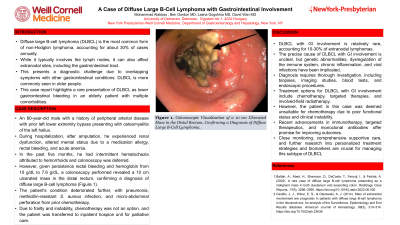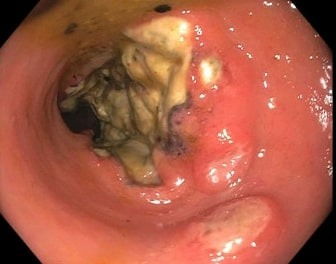Sunday Poster Session
Category: Colon
P0303 - Case Report: A Case of Diffuse Large B-Cell Lymphoma With Gastrointestinal Involvement
Sunday, October 22, 2023
3:30 PM - 7:00 PM PT
Location: Exhibit Hall

Has Audio

Mohammad Alabbas, MD
University of Debrecen
Debrecen, Hajdu-Bihar, Hungary
Presenting Author(s)
Mohammad Alabbas, MD1, Benjamin Gordon, MD2, Lasha Gogokhia, MD3, David Wan, BS, MD4
1University of Debrecen, Debrecen, Hajdu-Bihar, Hungary; 2New York Presbyterian Hospital/Weill Cornell Medical Center, New York, NY; 3New York-Presbyterian Hospital/Weill Cornell Medical Center, New York, NY; 4Weill Cornell Medicine, New York, NY
Introduction: Diffuse large B-cell lymphoma (DLBCL) is the most common form of non-Hodgkin lymphoma, accounting for about 30% of cases annually. While it typically involves the lymph nodes, it can also affect extranodal sites, including the gastrointestinal tract. This presents a diagnostic challenge due to overlapping symptoms with other gastrointestinal conditions. DLBCL is more commonly seen in older people. This case report highlights a rare presentation of DLBCL as lower gastrointestinal bleeding in an elderly patient with multiple comorbidities.
Case Description/Methods: An 80-year-old male with a history of peripheral arterial disease with prior left lower extremity bypass presenting with osteomyelitis of the left hallux. During hospitalization, after amputation, he experienced renal dysfunction, altered mental status due to a medication allergy, rectal bleeding, and acute anemia. In the past five months, he had intermittent hematochezia attributed to hemorrhoids and colonoscopy was deferred. However, given persistence rectal bleeding and hemoglobin from 10 g/dL to 7.6 g/dL, a colonoscopy performed revealed a 10 cm ulcerated mass in the distal rectum, confirming a diagnosis of diffuse large B-cell lymphoma (Figure 1). The patient's condition deteriorated further, with pneumonia, methicillin-resistant S. aureus infection, and micro-abdominal perforation from prior chemotherapy. Due to frailty and instability, chemotherapy was not an option, and the patient was transferred to inpatient hospice unit for palliative care.
Discussion: DLBCL with GI involvement is relatively rare, accounting for 10-30% of extranodal lymphomas. The precise cause of DLBCL with GI involvement is unclear, but genetic abnormalities, dysregulation of the immune system, chronic inflammation, and viral infections have been implicated. Diagnosis requires thorough investigation, including biopsies, imaging studies, blood tests, and endoscopic procedures. Treatment options for DLBCL with GI involvement include chemotherapy, targeted therapies, and involved-field radiotherapy. However, the patient in this case was deemed unsuitable for chemotherapy due to poor functional status and clinical instability. Recent advancements in immunotherapy, targeted therapeutics, and monoclonal antibodies offer promise for improving outcomes. Close monitoring, comprehensive supportive care, and further research into personalized treatment strategies and biomarkers are crucial for managing this subtype of DLBCL.

Disclosures:
Mohammad Alabbas, MD1, Benjamin Gordon, MD2, Lasha Gogokhia, MD3, David Wan, BS, MD4. P0303 - Case Report: A Case of Diffuse Large B-Cell Lymphoma With Gastrointestinal Involvement, ACG 2023 Annual Scientific Meeting Abstracts. Vancouver, BC, Canada: American College of Gastroenterology.
1University of Debrecen, Debrecen, Hajdu-Bihar, Hungary; 2New York Presbyterian Hospital/Weill Cornell Medical Center, New York, NY; 3New York-Presbyterian Hospital/Weill Cornell Medical Center, New York, NY; 4Weill Cornell Medicine, New York, NY
Introduction: Diffuse large B-cell lymphoma (DLBCL) is the most common form of non-Hodgkin lymphoma, accounting for about 30% of cases annually. While it typically involves the lymph nodes, it can also affect extranodal sites, including the gastrointestinal tract. This presents a diagnostic challenge due to overlapping symptoms with other gastrointestinal conditions. DLBCL is more commonly seen in older people. This case report highlights a rare presentation of DLBCL as lower gastrointestinal bleeding in an elderly patient with multiple comorbidities.
Case Description/Methods: An 80-year-old male with a history of peripheral arterial disease with prior left lower extremity bypass presenting with osteomyelitis of the left hallux. During hospitalization, after amputation, he experienced renal dysfunction, altered mental status due to a medication allergy, rectal bleeding, and acute anemia. In the past five months, he had intermittent hematochezia attributed to hemorrhoids and colonoscopy was deferred. However, given persistence rectal bleeding and hemoglobin from 10 g/dL to 7.6 g/dL, a colonoscopy performed revealed a 10 cm ulcerated mass in the distal rectum, confirming a diagnosis of diffuse large B-cell lymphoma (Figure 1). The patient's condition deteriorated further, with pneumonia, methicillin-resistant S. aureus infection, and micro-abdominal perforation from prior chemotherapy. Due to frailty and instability, chemotherapy was not an option, and the patient was transferred to inpatient hospice unit for palliative care.
Discussion: DLBCL with GI involvement is relatively rare, accounting for 10-30% of extranodal lymphomas. The precise cause of DLBCL with GI involvement is unclear, but genetic abnormalities, dysregulation of the immune system, chronic inflammation, and viral infections have been implicated. Diagnosis requires thorough investigation, including biopsies, imaging studies, blood tests, and endoscopic procedures. Treatment options for DLBCL with GI involvement include chemotherapy, targeted therapies, and involved-field radiotherapy. However, the patient in this case was deemed unsuitable for chemotherapy due to poor functional status and clinical instability. Recent advancements in immunotherapy, targeted therapeutics, and monoclonal antibodies offer promise for improving outcomes. Close monitoring, comprehensive supportive care, and further research into personalized treatment strategies and biomarkers are crucial for managing this subtype of DLBCL.

Figure: Figure 1: Colonoscopy revealing a 10 cm ulcerated mass in the distal rectum
Disclosures:
Mohammad Alabbas indicated no relevant financial relationships.
Benjamin Gordon indicated no relevant financial relationships.
Lasha Gogokhia indicated no relevant financial relationships.
David Wan indicated no relevant financial relationships.
Mohammad Alabbas, MD1, Benjamin Gordon, MD2, Lasha Gogokhia, MD3, David Wan, BS, MD4. P0303 - Case Report: A Case of Diffuse Large B-Cell Lymphoma With Gastrointestinal Involvement, ACG 2023 Annual Scientific Meeting Abstracts. Vancouver, BC, Canada: American College of Gastroenterology.
